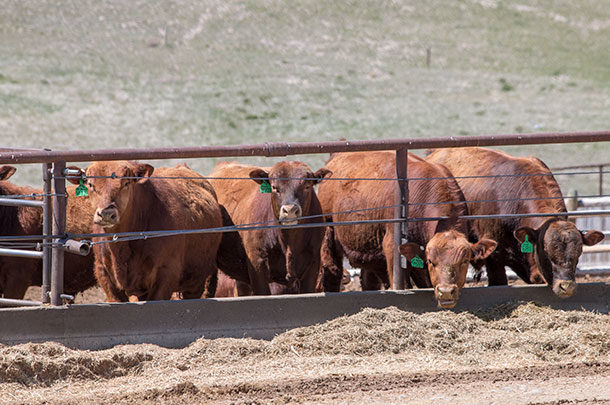Probiotics have become more popular with consumers in recent years. In the past, probiotics were only associated with foods such as yogurt, but as probiotics become more readily available to us in so many forms, education regarding the benefit of probiotics have driven researchers to dig deeper into the function of good bacteria.
From feedlots to pet treats, probiotics are even becoming more popular on the animal side, and research regarding probiotic benefits continues to show us how important the gut microbiome truly is to animal and human health. From performance to immunity and pathogen reduction, probiotics have shown that optimizing gut health leads to healthier, more productive animals.
The use of probiotics is not new – in the 1920s and 1930s, Lactobacillus acidophilus was commonly used by people to aid in digestive health. Probiotics are live microorganisms, which when consumed in adequate amounts, confer a health effect on the host (Word Health Organization, 2002). To give the health benefit, they must survive in the digestive tract.
Many but not all probiotics work in the small intestine where they produce lactic acid, creating a microenvironment with a reduced pH where pathogens do not thrive. This allows good bacteria to take hold and replicate. By increasing in number, they increase the surface area they inhabit in the small intestine, further reducing the area in which pathogens can take hold.
Building a strength bank
Probiotics also reduce pathogens by stimulating the immune system. As the immune response adapts and responds, pathogens will have less time to replicate and overwhelm the immune system. Probiotics are also known to produce peptides that inhibit pathogens. This is a direct action against pathogens where a probiotic produces a compound that will actively attack pathogens.
Another means being investigated is how probiotics help strengthen the epithelial tissue of the small intestine. The role of “leaky gut” regarding animal health is being heavily researched. Leaky gut leads to health decline, energy depletion that would otherwise be used for meat or milk production, and can lead to pathogens entering the bloodstream where they will ultimately end up in places such as the liver or lymph nodes.
Recent studies conducted using a method known as transepithelial electrical resistance have shown that adding a probiotic will increase the relative strength of the small intestine membrane, decreasing the amount of unwanted material to pass through the membrane or between the epithelial cells. When a pathogen like salmonella is added to these tests, the probiotic addition reduces the permeability of the membrane, reducing the likelihood of events like leaky gut.
Pathogens result in about 48 million cases of foodborne illness each year. CDC estimates that 12,000 people are hospitalized, and 3,000 people die from foodborne illness. According to the USDA Food Safety and Inspection Service, there were at least 15 recalls for foodborne pathogens in animal-based protein products last year in the U.S.
According to the FDA, Escherichia coli (E. coli), salmonella and listeria are listed as key foodborne pathogens in the U.S. While we typically see E. coli and salmonella as pathogens in beef, we must also acknowledge there are other pathogens that may contaminate our food sources and lead to illness.
The major pathogens attributed to beef production contamination are E. coli and salmonella. The effects of probiotics on these specific pathogens is an area of interest regarding the role of pre-harvest interventions on food safety.
Commercially available probiotics containing Lactobacillus animalis and Propionibacterium freudenreichii have been shown to decrease the prevalence and concentration of E. coli O157:H7 and salmonella in feedlot cattle. Determining pathogen risk in cattle pre- and post-harvest is challenging. The source of E. coli infections in humans as pathogenic bacteria occur by consuming food, produce or water that has become contaminated with fecal material. Therefore, many pre-harvest research studies look at how pathogen reduction in fecal material occurs.
Targeting pathogen reduction
Several probiotics on the market have shown to reduce fecal E. coli O157:H7 shedding, which can have positive impact during meat processing. Another beneficial method to determining pre-harvest pathogen reduction is by analyzing lymph nodes for pathogen levels. Specifically, salmonella has shown to be found in lower levels within lymph when cattle are given a probiotic in their daily feed ration. This can be very beneficial to the beef industry, specifically our ground meat products.
The continuation of research looking at pre-harvest pathogen reduction is important for human health and safety, but we also need to consider what is taking place within the gastrointestinal tract. The reduction in shedding of E. coli and decreased levels of salmonella in lymph nodes helps illustrate how probiotics can impact gut health, especially when animals are facing stressful challenges which will allow the animal to retain their optimal level of production.
Many times, when we think about the effects of probiotics on pathogens, we focus primarily on those that are colony-forming and produce lactic acid. However, another option exists that has potential for reducing pathogens: bacillus. These endospore-producing bacteria are hardier than most lactic-acid-producing bacteria. They function as enzyme producers, producing the enzymes needed to effectively digest the animal’s diet.
Bacilli are free-moving and act as hunter-killers toward pathogens. They will actively seek out pathogens to eliminate them. As they rapidly reproduce in the digestive tract, they form biofilms that produce bacteriocins or occupy binding sites needed by pathogenic bacteria. Testing has shown that some bacilli species and strains are better at pathogen inhibition than others.
However, once a stress event takes place, the balance of the population of the small intestine can be altered. There is constant battling between the pathogenic bacteria and those needed for normal production.
The meat industry works closely with the USDA to develop and implement rules and regulations aimed at making our food sources the safest in the world. Every individual involved in food production has a role in food safety. Probiotics are one option for producers to utilize for their part in reducing pathogen risk with the added benefit of making their cattle healthier – a win-win for producer and packer.











